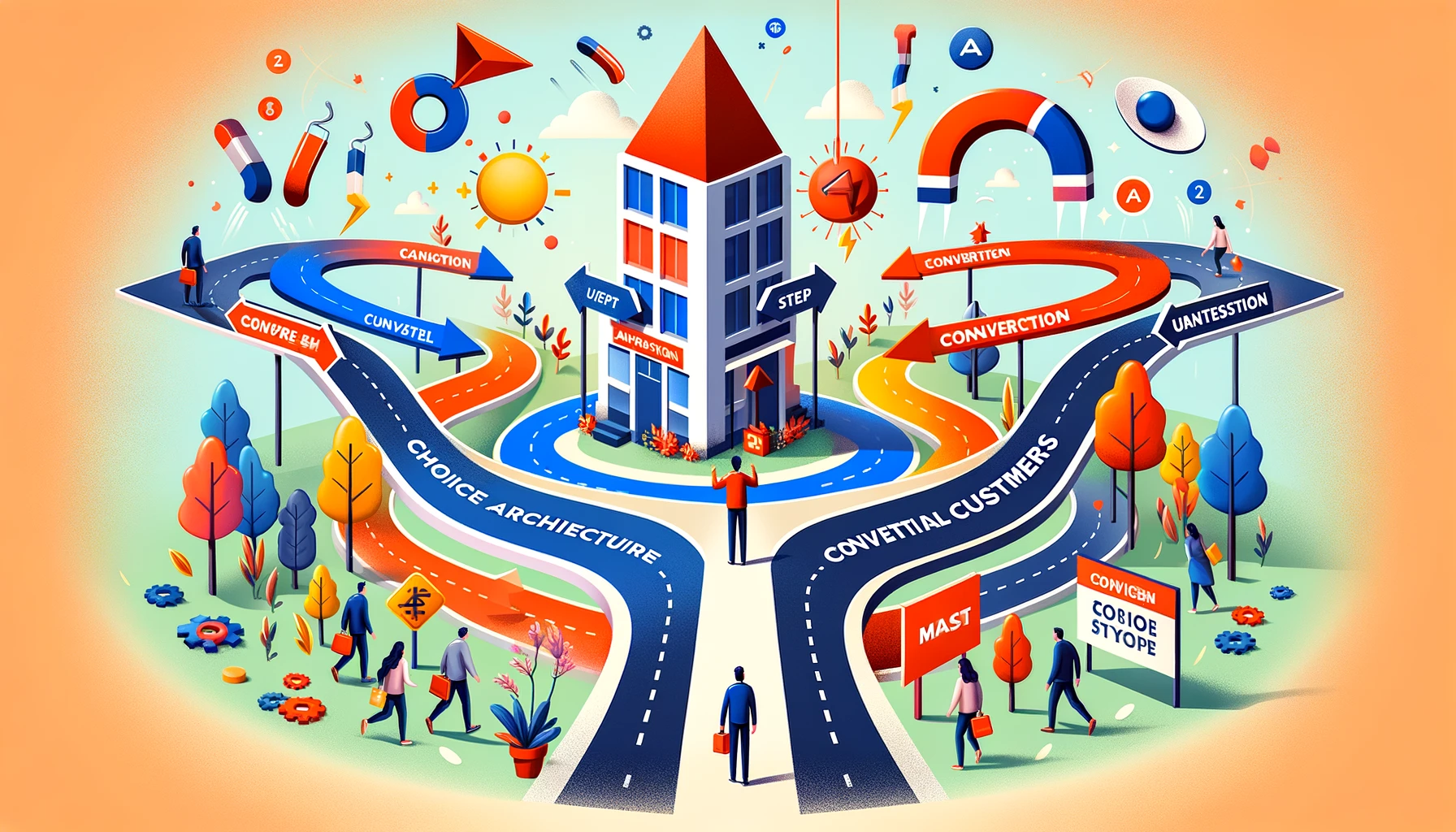Exploring Choice Architecture and Converting Potential Customers
What is Choice Architecture and How Does It Impact Decision Making?
Choice architecture is the way in which choices are presented to people, significantly influencing their decisions without restricting their freedom of choice. It's based on the understanding that the way options are arranged can impact the ease or difficulty of making a certain decision.
Understanding the Concept of Choice Architecture
Choice architecture involves structuring the context in which people make decisions to help them make better choices, often with the goal of improving decisions about health, wealth, and happiness. It's a foundational concept in behavioral economics, emphasizing that the presentation and arrangement of choices can nudge people towards beneficial decisions without limiting their options.
Key Role of Choice Architects in Influencing Decisions
Choice architects are individuals or organizations that organize the context of a decision. Their role is crucial because they influence decisions by arranging options in a way that can guide people towards a desired outcome. Richard Thaler and Cass Sunstein, prominent figures in behavioral economics, highlight that every design choice (like setting a default option) can significantly impact decision-making processes.
Examples of Choice Architecture in Real-Life Scenarios
Real-life examples of choice architecture include the layout of a cafeteria designed to promote healthier eating choices or the configuration of forms where the default option enrolls people in organ donation programs. These setups leverage behavioral insights to encourage beneficial choices without removing individuals' freedom to choose differently.
How Can the Nudge Theory Be Used as a Behavioral Tool?
The Nudge theory, proposed by Richard Thaler and Cass Sunstein in their book "Nudge," suggests subtle changes in the choice architecture can significantly influence behavior in predictable ways.
Applying the Principles of the Nudge Theory
The principles of Nudge theory involve making small changes in how choices are presented to encourage people to make decisions that are in their long-term interest. For instance, making a beneficial option the default choice (opt-out instead of opt-in) can improve participation rates in programs like organ donation without coercing people.
Exploring Cognitive Biases Within the Nudge Theory
Nudge theory takes into account various cognitive biases that affect decision-making, such as loss aversion, status quo bias, and the availability heuristic. By understanding these biases, choice architects can design decision-making environments that steer people towards making better choices, while still respecting their autonomy.
Benefits of Incorporating Nudges in Choice Architecture
Incorporating nudges into choice architecture can lead to significant benefits, including increased savings rates, higher participation in health and wellness programs, and improved environmental behaviors. Nudges help by simplifying complex decisions, setting beneficial defaults, and providing feedback that guides better choices, demonstrating the power of subtle influences in decision-making contexts.
Choice architecture and the Nudge theory offer powerful frameworks for influencing decision-making in ways that can lead to improved outcomes for individuals and societies. By thoughtfully designing the context in which decisions are made, choice architects can help people navigate complex choices more easily, leading to better decisions about health, wealth, and happiness, ultimately enhancing customer engagement and satisfaction in various domains, including technology and service design.
Who are the Prominent Figures in Choice Architecture?
Choice architecture has been profoundly influenced by several key figures, whose work has reshaped our understanding of decision-making processes.
Richard Thaler's Contribution to Behavioral Economics
Richard Thaler is a Nobel laureate renowned for his contributions to behavioral economics, significantly impacting the field of choice architecture. He introduced concepts like mental accounting, endowment effect, and nudges, demonstrating how people's decisions deviate from classical economic theory. Thaler's work has shown that by understanding the psychology behind decisions, we can design choices that help people make better decisions naturally.
Understanding the Role of Cass Sunstein in the Field of Choice Architecture
Cass Sunstein, a legal scholar, has played a crucial role in the development of choice architecture alongside behavioral economics. He has extensively explored how public and private organizations can structure choices to improve people's lives while also respecting freedom of choice. Sunstein's work on "libertarian paternalism" argues for designing choices that nudge people towards beneficial behaviors without restricting their freedom to choose.
The Collaboration Between Thaler and Sunstein in Shaping Decision-Making Processes
The collaboration between Richard Thaler and Cass Sunstein culminated in the influential book "Nudge," which explores how choice architecture can be utilized to improve decision-making outcomes. Their partnership has highlighted the importance of structuring choices in ways that nudge consumers toward better choices in health, finance, and environmental behavior, laying the foundation for applying behavioral science in public policy and business strategy.
How can Choice Architecture be Utilized to Improve Decision-Making?
Choice architecture offers practical strategies for enhancing decision-making processes, leveraging insights from behavioral science.
Implementing Default Options in Choice Architecture
One effective aspect of choice architecture is the implementation of default options, where choices are designed so that the most beneficial action is taken automatically unless the individual opts otherwise. This approach leverages status quo bias and people's tendency to stick with the default option, significantly influencing outcomes like registering as an organ donor or saving for retirement.
Utilizing Behavioral Science for Better Decision-Making Outcomes
Behavioral science insights can be applied through choice architecture to guide people towards making choices that align with their long-term goals. By understanding how people make decisions, choice architects may design interventions that help overcome biases like choice overload, facilitating easier and more beneficial decision-making processes.
Overcoming Biases Through Effective Choice Architecture
Effective choice architecture also involves structuring choice environments to mitigate the impact of cognitive biases such as loss aversion and overconfidence. By describing choice options clearly, limiting the number of alternatives to reduce choice overload, and utilizing decision aids, choice architecture can help individuals make more informed and optimal choices.
Choice architecture, underpinned by the groundbreaking work of figures like Richard Thaler and Cass Sunstein, provides a framework for influencing decision-making in a way that respects individual freedom while guiding people towards better outcomes. By applying principles of good choice architecture and insights from behavioral economics, organizations and policymakers can significantly improve how decisions are made, leading to enhanced well-being and consumer engagement.
Inagiffy: Your Ultimate Newsletter Marketing Partner
In today's crowded digital landscape, building genuine, lasting connections with your audience is more crucial than ever.
Enter Inagiffy – a premier newsletter marketing agency that understands the transformative power of well-crafted newsletters. We're not just about sending out emails; we're about curating stories, insights, and value that resonate deeply with your audience.
Our end-to-end solutions ensure that from ideation to delivery, every newsletter reflects your brand's essence and speaks directly to your audience's needs and aspirations. Let Inagiffy empower your brand, forging authentic relationships and driving engagement through the potent medium of newsletters.
Dive into the future of meaningful communication with us and watch your audience grow, engage, and thrive.

